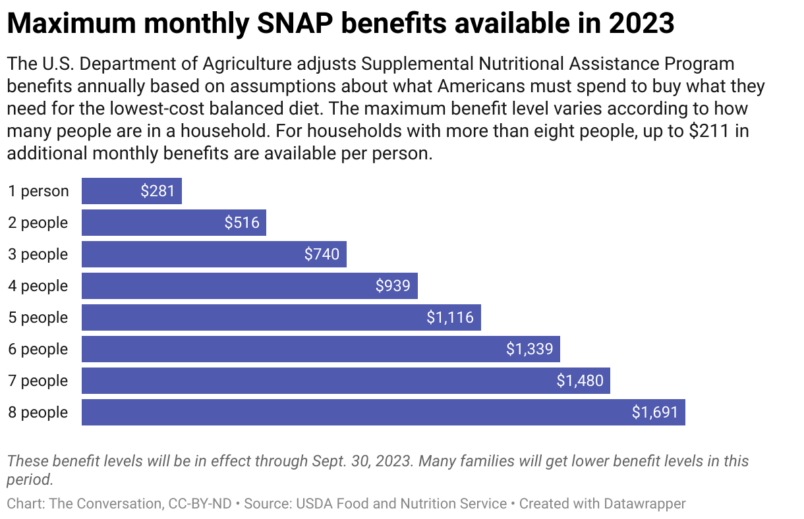These benefits make it easier for millions of Americans to buy groceries.

By Kelsey Pukelis
May 3, 2023
This article is part of TPM Cafe, TPM’s home for opinion and news analysis. It was originally published at The Conversation.
The House of Representatives has passed a bill that would cut spending, in part by expanding work requirements for the Supplemental Nutrition Assistance Program, through which nearly 43 million low-income Americans get help buying groceries. The House bill calls for this policy to apply to adults as old as 55, while today this policy only applies to adults under 50. Some Democrats, in contrast, are seeking to eliminate work requirements altogether.
The bill passed by a 217-215 vote, with all but four Republicans in favor and every Democrat opposed, on April 26, 2023. Tied to a standoff over raising the debt ceiling, the bill would also make Medicaid – the U.S. program that helps low-income and disabled people get health care – contingent on work requirements for some eligible Americans. It’s not clear whether that’s possible, since a federal court has struck down similar measures enacted in some states previously.
Since the Clinton administration, the government has required that at least some people getting SNAP, commonly known as food stamps, do paid work, get job training or volunteer – otherwise they can’t continue receiving benefits. Those requirements were paused in 2020 because of the COVID-19 pandemic. They are set to return in July 2023 regardless of the fate of the House bill – which is unlikely to pass in the Democratic-controlled Senate.
I’m a member of a team of economists studying the social safety net and work. Because the rationale for work requirements is that they encourage adults who are able to work to earn more money and become more economically self-sufficient, we wanted to determine whether this policy boosts employment and earnings. We also looked into whether SNAP work requirements lead low-income adults to lose their benefits.
We found that the policy doesn’t make people more likely to find a job or make more money, but it does make Americans who could use help buying groceries less likely to get it.

Tracing a similar case study
Adults with SNAP benefits who are subject to work requirements must document at least 80 hours per month of paid work, job training or volunteering. Otherwise, they can get the benefits for only three months within a three-year period.
Before the pandemic, these rules applied to most so-called “able-bodied” adults without children who were under 50, and that policy will again apply in July. There are some exceptions, such as if the person with benefits is caring for kids younger than 6, has disabilities incompatible with holding a steady job or is in a drug or alcohol rehabilitation program.
To determine this policy’s impact, we studied SNAP, employment and earnings data in Virginia from both the period of the state’s previous suspension of work requirements and afterward.
Virginia, like many other states, suspended work requirements for several years beginning in the Great Recession. During this period, adults could enroll in the program and continue to receive benefits regardless of their employment status.
In October 2013, however, Virginia reinstated work requirements, and they remained in effect in most counties for several years. In those areas, adults under the age of 50 without dependents who were considered able to work needed to either satisfy work requirements or receive an individual exemption to keep their SNAP benefits, while similar adults over the age of 50 did not.
We followed both age groups over time, comparing whether they worked and were getting SNAP benefits both before and after work requirements returned.
No employment boost
By comparing older and younger adults previously getting SNAP benefits, we found that work requirements did not increase employment or earnings 18 months after their reinstatement.
We also detected nearly identical patterns of employment before and after work requirements were reinstated for people in both age groups.
Adults without dependents, whether or not they lost their SNAP benefits to the resumption of work requirements, were earning at most an additional US$28 per month.
Many lost their benefits
But we did find that work requirements dramatically reduced the number of people enrolled in SNAP. Among the adults subject to work requirements once they were restored in 2013, over half lost their benefits because of the policy.
We also found that work requirements disproportionately led people who had faced great economic hardships, such as those without housing or earned income, to lose benefits.
Only 44% of the currently or formerly homeless people getting benefits remained enrolled in SNAP 18 months after work requirements were reinstated, compared with 64% of everyone else, our estimates suggest. Similarly, only 59% of those with no earned income remained enrolled, relative to 73% of those with prior earnings.
Because they are likely to qualify for an individual exemption to work requirements, adults with a history of a disability were more likely to retain benefits compared with others.
Adults kicked out of SNAP because of work requirements typically stood to lose $189 in benefits per month – the most a single person could obtain at the time. It also amounted to about two-thirds of their gross income.
We studied work requirements in Virginia because of the availability of detailed data on both earnings and SNAP benefits.
Although work requirements enforcement varies across states, we believe that our results are likely to be representative of the impacts of this policy, since SNAP recipients in Virginia look similar to nationwide averages on most demographic characteristics except race.

Our findings do suggest that work requirements restrain federal spending by reducing the number of people getting SNAP benefits.
But our work also indicates that in today’s context, these savings would be at the expense of already vulnerable people facing additional economic hardship at a time when a new recession could be around the corner.
This article is republished from The Conversation under a Creative Commons license. Read the original article.
No comments:
Post a Comment